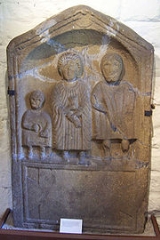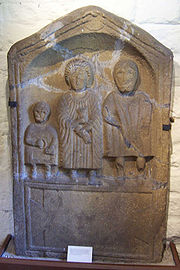
Olicana
Encyclopedia
Olicana is generally recognised as the Roman fort
on the south bank of the River Wharfe
, situated at the centre of where Ilkley
, a Victorian spa town
in West Yorkshire
, England
now stands.
mentions Olikana in his Geographia
(c. 150), although Rivet and Smith give Olenacum as the proper form of the name, rejecting Ptolemy's Olikana as corrupt. The 1086 Domesday Book
gives Ilecliue also variants Illecliue, Illiclei and Illicleia for Ilkley. Modern scholarship has, however, suggested that the Roman name would be better applied to the fort at Elslack
(Eleslac in Domesday Book
) near Skipton
.
 The first fort at Ilkley was founded by Agricola
The first fort at Ilkley was founded by Agricola
around 80 AD and was largely constructed of wood, but this was later abandoned in the 120s. A second fort was erected around 161 AD which survived for 30 years, before being burnt down, perhaps during a documented rebellion by the inhabitants of northern Britain. It was immediately replaced by a stone fort which survived until the end of the Roman period. The fort was abandoned in the late 4th or early 5th century.
A substantial civil settlement, the vicus
, formed the nucleus of the village that followed. Excavations have yet to reveal continuous habitation from Roman times, but it is quite likely that a village established itself within the ramparts of the fort following the Roman departure. Anglo-Saxon
settlement probably did not take place until well into the seventh century, and the sculptured crosses are evidence of a church here in the eighth and ninth centuries.
Art Gallery & Museum. Around the area are four signs showing the edges of the walls of the fort. The area of the fort extends underneath the Manor House and nearby All Saints Parish Church. The church has a collection of Roman altars and Anglo-Saxon crosses. The Roman altars date to the reigns of Antoninus Pius
(138 to 161), and Septimius Severus
and his son Caracalla
(211 to 217).
Castra
The Latin word castra, with its singular castrum, was used by the ancient Romans to mean buildings or plots of land reserved to or constructed for use as a military defensive position. The word appears in both Oscan and Umbrian as well as in Latin. It may have descended from Indo-European to Italic...
on the south bank of the River Wharfe
River Wharfe
The River Wharfe is a river in Yorkshire, England. For much of its length it is the county boundary between West Yorkshire and North Yorkshire. The name Wharfe is Celtic and means "twisting, winding".The valley of the River Wharfe is known as Wharfedale...
, situated at the centre of where Ilkley
Ilkley
Ilkley is a spa town and civil parish in West Yorkshire, in the north of England. Ilkley civil parish includes the adjacent village of Ben Rhydding and is a ward within the metropolitan borough of Bradford. Approximately north of Bradford, the town lies mainly on the south bank of the River Wharfe...
, a Victorian spa town
Spa town
A spa town is a town situated around a mineral spa . Patrons resorted to spas to "take the waters" for their purported health benefits. The word comes from the Belgian town Spa. In continental Europe a spa was known as a ville d'eau...
in West Yorkshire
West Yorkshire
West Yorkshire is a metropolitan county within the Yorkshire and the Humber region of England with a population of 2.2 million. West Yorkshire came into existence as a metropolitan county in 1974 after the passage of the Local Government Act 1972....
, England
England
England is a country that is part of the United Kingdom. It shares land borders with Scotland to the north and Wales to the west; the Irish Sea is to the north west, the Celtic Sea to the south west, with the North Sea to the east and the English Channel to the south separating it from continental...
now stands.
Identification
The traditional view is that Olicana is the fort at Ilkley, but the identification is not settled. PtolemyPtolemy
Claudius Ptolemy , was a Roman citizen of Egypt who wrote in Greek. He was a mathematician, astronomer, geographer, astrologer, and poet of a single epigram in the Greek Anthology. He lived in Egypt under Roman rule, and is believed to have been born in the town of Ptolemais Hermiou in the...
mentions Olikana in his Geographia
Geographia (Ptolemy)
The Geography is Ptolemy's main work besides the Almagest...
(c. 150), although Rivet and Smith give Olenacum as the proper form of the name, rejecting Ptolemy's Olikana as corrupt. The 1086 Domesday Book
Domesday Book
Domesday Book , now held at The National Archives, Kew, Richmond upon Thames in South West London, is the record of the great survey of much of England and parts of Wales completed in 1086...
gives Ilecliue also variants Illecliue, Illiclei and Illicleia for Ilkley. Modern scholarship has, however, suggested that the Roman name would be better applied to the fort at Elslack
Elslack
Elslack is a village and civil parish in the Craven district of North Yorkshire, England, near to the border with Lancashire and 4 miles west of Skipton. Thornton in Craven is nearby. It is mentioned in the 1086 Domesday Book as Eleslac. The Tempest Arms is a large pub in the village, sited by the...
(Eleslac in Domesday Book
Domesday Book
Domesday Book , now held at The National Archives, Kew, Richmond upon Thames in South West London, is the record of the great survey of much of England and parts of Wales completed in 1086...
) near Skipton
Skipton
Skipton is a market town and civil parish within the Craven district of North Yorkshire, England. It is located along the course of both the Leeds and Liverpool Canal and the River Aire, on the south side of the Yorkshire Dales, northwest of Bradford and west of York...
.
History

Gnaeus Julius Agricola
Gnaeus Julius Agricola was a Roman general responsible for much of the Roman conquest of Britain. His biography, the De vita et moribus Iulii Agricolae, was the first published work of his son-in-law, the historian Tacitus, and is the source for most of what is known about him.Born to a noted...
around 80 AD and was largely constructed of wood, but this was later abandoned in the 120s. A second fort was erected around 161 AD which survived for 30 years, before being burnt down, perhaps during a documented rebellion by the inhabitants of northern Britain. It was immediately replaced by a stone fort which survived until the end of the Roman period. The fort was abandoned in the late 4th or early 5th century.
A substantial civil settlement, the vicus
Vicus
Vicus may refer to:*Vicus , plural vici, a neighborhood or local administrative unit of ancient Rome**Vicus Tuscus in Rome**Vicus Jugarius, leading into the Roman Forum** Gensis in Moesia Superior...
, formed the nucleus of the village that followed. Excavations have yet to reveal continuous habitation from Roman times, but it is quite likely that a village established itself within the ramparts of the fort following the Roman departure. Anglo-Saxon
Anglo-Saxons
Anglo-Saxon is a term used by historians to designate the Germanic tribes who invaded and settled the south and east of Great Britain beginning in the early 5th century AD, and the period from their creation of the English nation to the Norman conquest. The Anglo-Saxon Era denotes the period of...
settlement probably did not take place until well into the seventh century, and the sculptured crosses are evidence of a church here in the eighth and ninth centuries.
The site today
A wall, once part of the fort, can still be seen near the town's old Manor HouseManor house
A manor house is a country house that historically formed the administrative centre of a manor, the lowest unit of territorial organisation in the feudal system in Europe. The term is applied to country houses that belonged to the gentry and other grand stately homes...
Art Gallery & Museum. Around the area are four signs showing the edges of the walls of the fort. The area of the fort extends underneath the Manor House and nearby All Saints Parish Church. The church has a collection of Roman altars and Anglo-Saxon crosses. The Roman altars date to the reigns of Antoninus Pius
Antoninus Pius
Antoninus Pius , also known as Antoninus, was Roman Emperor from 138 to 161. He was a member of the Nerva-Antonine dynasty and the Aurelii. He did not possess the sobriquet "Pius" until after his accession to the throne...
(138 to 161), and Septimius Severus
Septimius Severus
Septimius Severus , also known as Severus, was Roman Emperor from 193 to 211. Severus was born in Leptis Magna in the province of Africa. As a young man he advanced through the customary succession of offices under the reigns of Marcus Aurelius and Commodus. Severus seized power after the death of...
and his son Caracalla
Caracalla
Caracalla , was Roman emperor from 198 to 217. The eldest son of Septimius Severus, he ruled jointly with his younger brother Geta until he murdered the latter in 211...
(211 to 217).
External links
- Ilkley Manor House - Art Gallery and Museum
- ILKLEY - The Romans in West Yorkshire - West Yorkshire Archaeology Advisory Service

